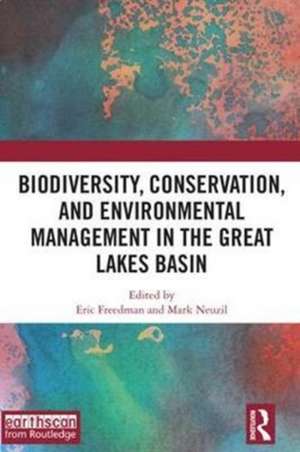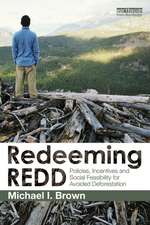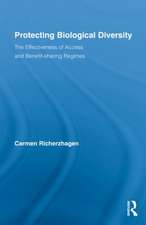Biodiversity, Conservation and Environmental Management in the Great Lakes Basin
Editat de Eric Freedman, Mark Neuzilen Limba Engleză Hardback – 9 noi 2017
Chapters by U.S. and Canadian scholars and practitioners represent a wide range of natural science and social science fields, including environmental sciences, geography, political science, natural resources, mass communications, environmental history and communication, public health, and economics. The book covers threats from invasive species, industrial development, climate change, agricultural and chemical runoff, species extinction, habitat restoration, environmental disease, indigenous conservation efforts, citizen engagement, environmental regulation, and pollution.Overall the book provides political, cultural, economic, scientific, and social contexts for recognizing and addressing the environmental challenges faced by the Great Lakes Basin.
| Toate formatele și edițiile | Preț | Express |
|---|---|---|
| Paperback (1) | 270.67 lei 6-8 săpt. | |
| Taylor & Francis – 29 iul 2019 | 270.67 lei 6-8 săpt. | |
| Hardback (1) | 1001.07 lei 6-8 săpt. | |
| Taylor & Francis – 9 noi 2017 | 1001.07 lei 6-8 săpt. |
Preț: 1001.07 lei
Preț vechi: 1220.81 lei
-18% Nou
Puncte Express: 1502
Preț estimativ în valută:
191.55€ • 200.53$ • 158.50£
191.55€ • 200.53$ • 158.50£
Carte tipărită la comandă
Livrare economică 05-19 aprilie
Preluare comenzi: 021 569.72.76
Specificații
ISBN-13: 9781138285811
ISBN-10: 1138285811
Pagini: 236
Ilustrații: 76
Dimensiuni: 156 x 234 mm
Greutate: 0.48 kg
Ediția:1
Editura: Taylor & Francis
Colecția Routledge
Locul publicării:Oxford, United Kingdom
ISBN-10: 1138285811
Pagini: 236
Ilustrații: 76
Dimensiuni: 156 x 234 mm
Greutate: 0.48 kg
Ediția:1
Editura: Taylor & Francis
Colecția Routledge
Locul publicării:Oxford, United Kingdom
Public țintă
Postgraduate and UndergraduateCuprins
1. Introduction: Examining the terrain Part I: Habitat, conservation, and restoration 2. The dam dilemma for fisheries management in the Great Lakes 3. Irrigation in the Great Lakes Basin: prospects and conflicts 4. Artificial reefs and reef restoration in the Laurentian Great Lakes Part II: Extinction & survival 5. Georgian Bay, Lake Huron: turtles and their wetland habitat in a changing landscape 6. Framing extinction: Societal attitudes toward the passenger pigeon in editorials and opinion pieces 7. Recovering the ecology of fear: Cascading effects of gray wolf predation and competition in a Great Lakes Basin forest 8. Linear corridors and predator movement dynamics in the Great Lakes Basin Part III: Pollution, climate change, and invasive species 9. Toxicants in the Great Lakes: living with a toxic legacy while managing for chemicals of emerging concern 10. Water quality in the Great Lakes: Interactions between nutrient pollution, invasive species, and climate change 11. Emerald ash borer, black ash, and Native American basketmaking: Invasive insects, forest ecosystems and cultural practices Part IV: Public Policy 12. Legislating the Great Lakes: socially constructing water through congressional discourse 13. Conservation authorities in Ontario: key players in the governance of invasive and endangered species 14. Citizen engagement, interpretation, and resource management in the Great Lakes Basin 15. 7 Indigenous principles for successful cooperation in Great Lakes conservation initiatives Part V: Conclusions 16. Through the crystal ball
Notă biografică
Eric Freedman is Knight Chair, Director of the Knight Center for Environmental Journalism, and Professor of Journalism at Michigan State University, USA. He also won a Pulitzer Prize in Journalism.
Mark Neuzil is Professor of Communication and Journalism at University of St Thomas, Minnesota, USA.
Mark Neuzil is Professor of Communication and Journalism at University of St Thomas, Minnesota, USA.
Descriere
This multidisciplinary book presents recent research to demonstrate the interconnected nature of the environmental challenges facing the The Great Lakes Basin in North America, and where threats to habitats and biodiversity have economic, political, national security, and cultural implications and ramifications that cross the US-Canadian border.






















